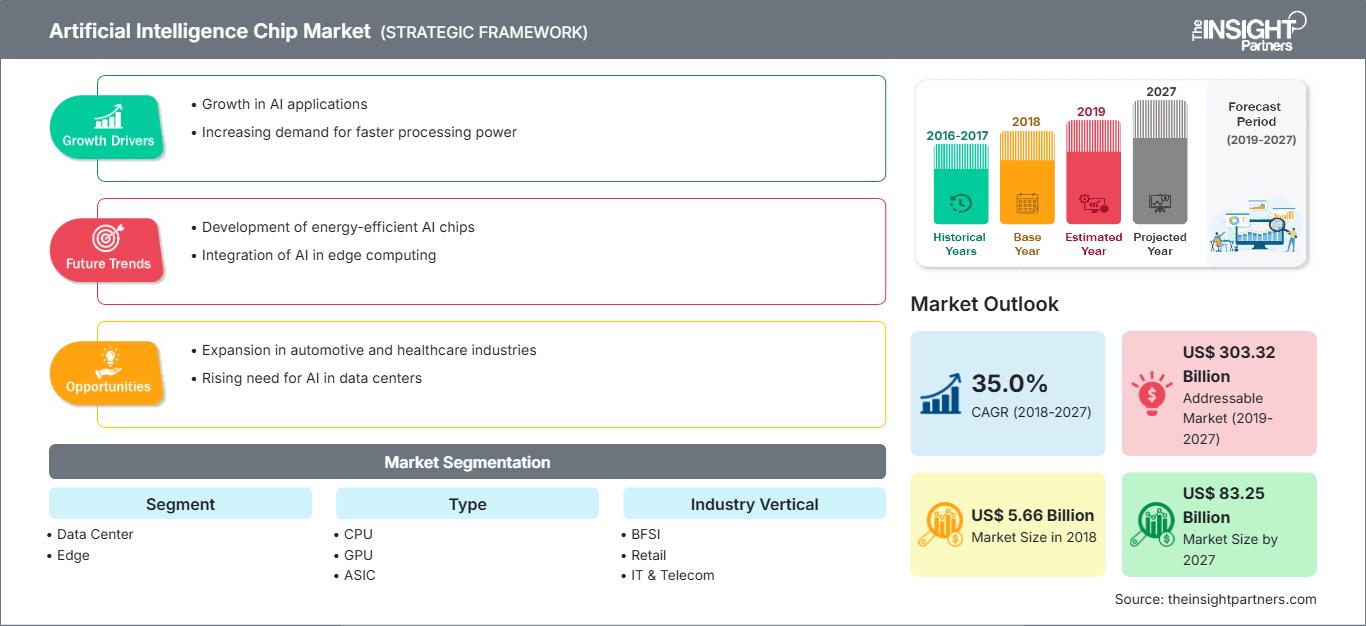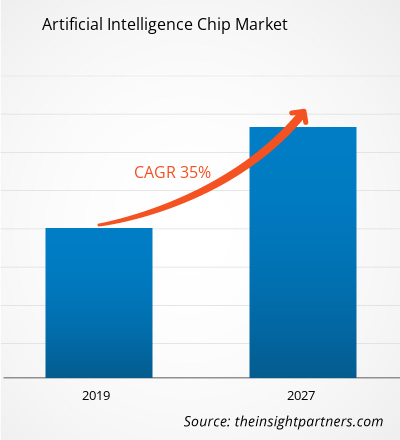Il mercato dei chip per l'intelligenza artificiale è stato valutato a 5.658,1 milioni di dollari nel 2018 e si prevede che raggiungerà gli 83.252,7 milioni di dollari entro il 2027; si prevede una crescita a un CAGR del 35,0% tra il 2019 e il 2027.
Con la disponibilità di enormi quantità di dati e l'ampia scalabilità della potenza di calcolo basata sul cloud, l'intelligenza artificiale è diventata una tendenza di grande impatto in tutti i settori negli ultimi anni. Nell'attuale mondo digitale, l'informazione è la chiave per il successo delle aziende e per mantenere una crescita sostenibile. La maggior parte dei settori, in particolare il settore dei servizi, fa ampio affidamento sull'analisi dei dati per ottenere informazioni aziendali utili e rimanere competitivi sul mercato. Le aziende hanno costantemente automatizzato i propri processi aziendali, che in precedenza venivano gestiti in modo programmatico o manuale. Con il progresso dei chip per l'intelligenza artificiale e l'introduzione di chip personalizzati per applicazioni specifiche, le aziende hanno ora la capacità di raccogliere analisi in tempo reale e di trasformare i dati in informazioni fruibili. Sono numerosi i casi d'uso disponibili nel mercato dei chip di intelligenza artificiale, in cui l'IA viene implementata con successo in vari settori verticali.
Le principali applicazioni di intelligenza artificiale per cui vengono utilizzati i chip di intelligenza artificiale includono l'apprendimento automatico (ML), l'elaborazione del linguaggio naturale (NLP), i sistemi esperti, il riconoscimento vocale automatico, la pianificazione dell'IA e la visione artificiale.
Personalizza questo rapporto in base alle tue esigenze
Potrai personalizzare gratuitamente qualsiasi rapporto, comprese parti di questo rapporto, o analisi a livello di paese, pacchetto dati Excel, oltre a usufruire di grandi offerte e sconti per start-up e università
Mercato dei chip per l'intelligenza artificiale: Approfondimenti strategici

- Ottieni le principali tendenze chiave del mercato di questo rapporto.Questo campione GRATUITO includerà l'analisi dei dati, che vanno dalle tendenze di mercato alle stime e alle previsioni.
Approfondimenti di mercato: i crescenti investimenti nelle startup di chip di intelligenza artificiale alimenteranno il mercato durante il periodo di previsione. L'intelligenza artificiale e le sue applicazioni, come l'apprendimento automatico e il deep learning, hanno registrato una crescita esponenziale negli ultimi anni. L'intelligenza artificiale viene ampiamente utilizzata in numerosi settori, dalle applicazioni di cloud computing agli assistenti digitali e ai veicoli a guida autonoma/a guida autonoma. Con l'aumento dei casi d'uso dell'intelligenza artificiale e l'evoluzione del panorama del mercato, i progressi nei chip attuali sono diventati una necessità. L'intelligenza artificiale è utilizzata principalmente nel mercato della formazione dei data center, dove NVIDIA è leader di mercato. Tuttavia, la domanda di chip di intelligenza artificiale personalizzati per applicazioni specifiche e l'inferenza su edge e data center sono i segmenti in rapida crescita nel mercato dei chip di intelligenza artificiale, e molte nuove startup stanno emergendo per sfruttare questo mercato. Approfondimenti di segmento: In base al segmento, il mercato dei chip di intelligenza artificiale si divide in applicazioni per data center/cloud e edge. Nel 2018, il Data Center ha rappresentato la quota maggiore del mercato globale. Attualmente, la principale applicazione dei chip artificiali è nelle applicazioni data center/cloud. I chip di intelligenza artificiale nei data center vengono utilizzati sia per scopi di training che di inferenza. Il training è un processo in cui gli algoritmi di intelligenza artificiale analizzano i dati, apprendono e quindi utilizzano tali informazioni per rispondere a problemi del mondo reale. Un'enorme quantità di dati viene analizzata dagli algoritmi di intelligenza artificiale durante il processo di training. Per aiutare gli sviluppatori a ridurre i processi di sviluppo della tecnologia di intelligenza artificiale, i produttori di chip dovrebbero non solo concentrarsi sull'aumento delle prestazioni del processore, ma anche fornire un intero ecosistema che includa hardware, framework e altri strumenti di supporto.Approfondimenti sulla tipologia
Potrai personalizzare gratuitamente qualsiasi rapporto, comprese parti di questo rapporto, o analisi a livello di paese, pacchetto dati Excel, oltre a usufruire di grandi offerte e sconti per start-up e università
Mercato dei chip per l'intelligenza artificiale: Approfondimenti strategici

- Ottieni le principali tendenze chiave del mercato di questo rapporto.Questo campione GRATUITO includerà l'analisi dei dati, che vanno dalle tendenze di mercato alle stime e alle previsioni.
In base alla tipologia, il mercato dei chip di intelligenza artificiale si divide in CPU, ASIC, GPU, FPGA e altri. Il segmento della tipologia di GPU ha rappresentato la quota maggiore del mercato globale nel 2018. Attualmente, nelle applicazioni di intelligenza artificiale, le unità di elaborazione grafica o GPU sono l'hardware più utilizzato. L'elevato parallelismo e la larghezza di banda di memoria delle GPU le rendono l'opzione più praticabile per applicazioni di machine learning e deep learning, soprattutto nell'ambito della formazione. Inizialmente, le GPU venivano utilizzate per accelerare un gran numero di calcoli di moltiplicazione e addizione eseguiti nel rendering grafico. Con l'aumento della domanda di grafica ad alte prestazioni, è cresciuta anche la domanda di GPU potenti.
Gli operatori del mercato si concentrano su innovazioni e sviluppi di nuovi prodotti integrando tecnologie e funzionalità avanzate nei loro prodotti per competere con la concorrenza.
- A marzo 2019, AMD ha stretto una partnership con ScaleMP che consente agli OEM di server AMD di creare sistemi con 4, 8 e fino a 128 socket di processore, fino a 8.192 CPU e 256 terabyte di memoria condivisa.
- A luglio 2018, Google ha presentato Edge TPU, un nuovo chip di intelligenza artificiale di piccole dimensioni per l'apprendimento automatico su dispositivo. Edge TPU è un circuito integrato specifico per applicazione (ASIC) di Google progettato appositamente per eseguire l'intelligenza artificiale in edge. Offre prestazioni elevate in un ingombro fisico e di potenza ridotto, consentendo l'implementazione di un'intelligenza artificiale ad alta precisione in periferia.
Approfondimenti regionali sul mercato dei chip per l'intelligenza artificiale
Le tendenze regionali e i fattori che influenzano il mercato dei chip per l'intelligenza artificiale durante il periodo di previsione sono stati ampiamente spiegati dagli analisti di The Insight Partners. Questa sezione illustra anche i segmenti e la geografia del mercato dei chip per l'intelligenza artificiale in Nord America, Europa, Asia-Pacifico, Medio Oriente e Africa, America meridionale e centrale.
Ambito del rapporto sul mercato dei chip di intelligenza artificiale
| Attributo del rapporto | Dettagli |
|---|---|
| Dimensioni del mercato in 2018 | US$ 5.66 Billion |
| Dimensioni del mercato per 2027 | US$ 83.25 Billion |
| CAGR globale (2018 - 2027) | 35.0% |
| Dati storici | 2016-2017 |
| Periodo di previsione | 2019-2027 |
| Segmenti coperti |
By Segmento
|
| Regioni e paesi coperti | Nord America
|
| Leader di mercato e profili aziendali chiave |
|
Densità degli operatori del mercato dei chip per l'intelligenza artificiale: comprendere il suo impatto sulle dinamiche aziendali
Il mercato dei chip per l'intelligenza artificiale è in rapida crescita, trainato dalla crescente domanda degli utenti finali, dovuta a fattori quali l'evoluzione delle preferenze dei consumatori, i progressi tecnologici e una maggiore consapevolezza dei vantaggi del prodotto. Con l'aumento della domanda, le aziende stanno ampliando la propria offerta, innovando per soddisfare le esigenze dei consumatori e sfruttando le tendenze emergenti, alimentando ulteriormente la crescita del mercato.

- Ottieni il Mercato dei chip per l'intelligenza artificiale Panoramica dei principali attori chiave
- Data Center
- Edge
Mercato dei chip per l'intelligenza artificiale - per tipo
- CPU
- GPU
- ASIC
- FPGA
- Altri
Mercato dei chip per l'intelligenza artificiale - per settore verticale
- BFSI
- Vendita al dettaglio
- IT e telecomunicazioni
- Automotive e trasporti
- Sanità
- Media e Intrattenimento
- Altro
Mercato dell'intelligenza artificiale - per area geografica
Nord America
- Stati Uniti
- Canada
- Messico
Europa
- Francia
- Germania
- Italia
- Russia
- Regno Unito
- Resto d'Europa
Asia Pacifico (APAC)
- Corea del Sud
- Cina
- India
- Australia
- Giappone
- Resto dell'Asia Pacifico
Medio Oriente e Africa (MEA)
- Arabia Saudita
- Emirati Arabi Uniti
- Sudafrica
- Resto del MEA
Sud America (SAM)
- Brasile
- Argentina
- Resto del Sud America (SAM)
Mercato dei chip per l'intelligenza artificiale - Profili aziendali
- Advanced Micro Devices, Inc.
- Google, Inc.
- Huawei Technologies Co., Ltd
- IBM
- Intel Corporation
- Micron Technology, Inc.
- NVIDIA Corporation
- QUALCOMM Incorporated
- Samsung Electronics Co., Ltd.
- Xilinx, Inc.
- Analisi storica (2 anni), anno base, previsione (7 anni) con CAGR
- Analisi PEST e SWOT
- Valore/volume delle dimensioni del mercato - Globale, Regionale, Nazionale
- Industria e panorama competitivo
- Set di dati Excel
Report recenti
Testimonianze
Motivo dell'acquisto
- Processo decisionale informato
- Comprensione delle dinamiche di mercato
- Analisi competitiva
- Analisi dei clienti
- Previsioni di mercato
- Mitigazione del rischio
- Pianificazione strategica
- Giustificazione degli investimenti
- Identificazione dei mercati emergenti
- Miglioramento delle strategie di marketing
- Aumento dell'efficienza operativa
- Allineamento alle tendenze normative




















 Ottieni un campione gratuito per - Mercato dei chip per l'intelligenza artificiale
Ottieni un campione gratuito per - Mercato dei chip per l'intelligenza artificiale